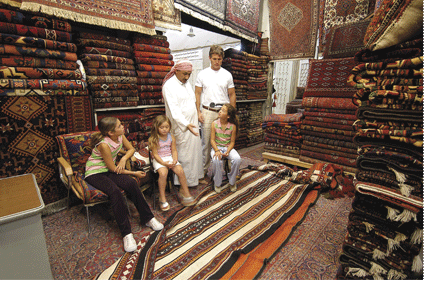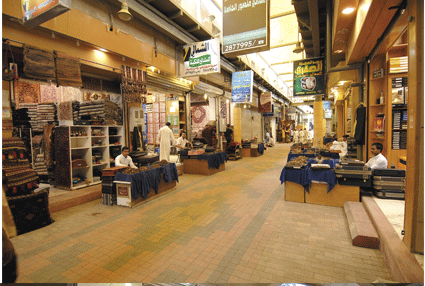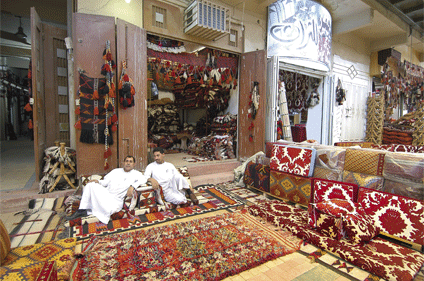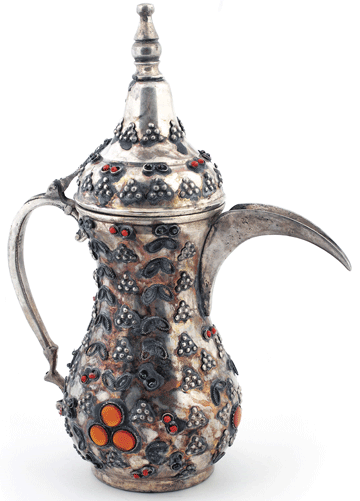
 There are many kinds of incense wood, including the Cambodian, Malaysian and Indonesian. The best though is the Indian. Those from Java costs SR50,000 per kilogram.
There are many kinds of incense wood, including the Cambodian, Malaysian and Indonesian. The best though is the Indian. Those from Java costs SR50,000 per kilogram.
Souk Al Zall is noted for its traditional Arabic rugs, antiques and ancient swords. Shopping at this market is almost like sightseeing, as tourists from all over the world flock to this market in search of goods.
Al Zall Souk:
Promoting Souks as Tourist Attractions
The Supreme Commission for Tourism (SCT), in cooperation with the Ministry of Municipal and Rural Affairs, has put its finishing touches on the first stage of a development and rehabilitation program for traditional souks as part of its effort to boost tourism. Such souks include the Al-Zall traditional market of
According to Dr. Ali Al Ghabban, advisor to the secretary-general of the Culture and Heritage Department in the SCT, these souks are rare in the market and, therefore, give
The main thrust of SCT’s plan is that the ambiance of these souks should be preserved and ,perhaps, improved, along with a parallel effort to address their problems. A development plan should be put forward and investments encouraged within the framework of the broad objectives to promote souks as tourist attractions.
One of the problems facing these souks is the loss of their identity resulting from the clash between tradition and modernity in the architectural pattern. As a result, new buildings overlap the old ones, which lose their traditional flavor.
 Al Ghabban said four souks have been selected for the second stage of SCT’s program—Zahran Al Janub souk in Asir, Al Naeyria souk in the Eastern Province, Hail al Shaabi souk in Hail, and Makkah’s Al Quz souk. The Commission delegated the job of planning and designing to a consultancy office, which, in turn, will report to the Ministry of Municipal Affairs for final implementation of the project.
Al Ghabban said four souks have been selected for the second stage of SCT’s program—Zahran Al Janub souk in Asir, Al Naeyria souk in the Eastern Province, Hail al Shaabi souk in Hail, and Makkah’s Al Quz souk. The Commission delegated the job of planning and designing to a consultancy office, which, in turn, will report to the Ministry of Municipal Affairs for final implementation of the project.
As far as
The following is a list of the most popular souks in the bustling city:
Al Batha Souk: Located in central
Al Deira Souk: This souk is renowned for its traditional goods, such as men’s traditional dress, garments and accessories from time long past. It also offers a range of silverware, antiques, old silver jewelry, in addition to Arab spices and traditional clothes.
Al Zall Souk: It is noted for its traditional Arabic rugs, antiques and ancient swords. Shopping in this market is almost like sightseeing, as tourists from all over the world flock to this market in search of goods.
The 30-year-old Al-Zall traditional market in
It features carpets from Saudi Arabia, India, Iran and Pakistan; Java and Indian scents of the finest quality , with one kilo sometimes fetching SR50,000 ; and pottery, knives and rosaries, Masbahah which have drawn the attention of many foreign visitors.
Visiting the market, one can visualize the atmosphere of different epochs through the rare antiques which go back to olden times. These include old woven textiles, Saudi traditional garments, plenty of presents, and antiques that conjure up vivid memories of the past.
The market itself is covered, its streets are narrow; however, you will find in it handmade artifacts that reflect time and conjures images of history.
The market could be the most vintage of all traditional markets in the Gulf. Located behind the Ma’eqilliah market in the Dirah area, it has undergone renovations.
It attracts old and antique items such as swords, shotguns, shields, traditional coffee kettles and old male robes from the different parts of
Swords and Daggers
There are different kinds of swords, according to Abdullah bin Ebrahim Al-Shahin who lives near the market and who has been working there for 20 years.
One kind is Al-Jowhar with its roots from
 If we classify swords according to their strength, we will find the Indian sword at the very top, followed by those from
If we classify swords according to their strength, we will find the Indian sword at the very top, followed by those from
Daggers are also of different kinds, of which there is small, medium and big. Each has specific traditional garments that go with it, such as the “Sayah” ( a kind of robe open at both sides), the head band, and the “Shimagh” head scarf or the Kashmiri head scarf. These are worn during festivals such as Eid; for example, when the “Sayah” is worn the dagger is hung around the waist.
On the other hand, Najrani daggers are encrusted with silver; some of its most famous crafters are Al-safayyan in
There are also a number of belts, with each one having a specific use. For example, the one encrusted with silver and has drawings of inscriptions and different colors, is used for the traditional war dance called “Ardah”. It is a very special dagger used in general and official festivities.
Coffee Kettles and Shotguns
Even the simplest of traditional coffee kettles have different shapes and sizes. We find the “Mahmoud” kettles, “Hasawi kettles” (from Al-Ahsa) and the “Quraishi” kettle (a very expensive kind from Makkah), among others. There are also very big ones but these are used for decorative purposes only.
As for shotguns, the short ones are called “Chivalry”, used by horse or camel riders while hunting or at war. The longer ones are used to shoot while standing. These are the Sultani , English, Persian and Moroccan. The German rifles in the market were made in 1815, while the French were made in 1876. The French is called the “finger” as it has a finger like lever on the side; there is also one called the “Fiver” as it has only five bullets. There are even ones with ten bullets.
Thobes and Iqaals
What is surprising is that the Saudi youth are not very interested in the traditional robe called “bisht” as much as they are interested in the modern ones. Of course, each individual has his own taste.
Some of the more famous robes are the ones made of camel skin and the “Abushihr” (Iranian). There are also the “Hasawi”, the “Qattan” and “Al-kharas” These robes cannot be surpassed in quality and are worn by illustrious people. The more common ones worn by people in general come from
Regarding the headbands “Iqaals”, these are made in the Kingdom,
Rosaries
The Al-Zall market is rich in traditional rosaries of multiple colors. The Yusr rosary from Makkah is probably the most famous and is made from natural stones. The price varies from SR500 to SR1,000 as they, unlike other rosaries, are made with extreme precision; some of these are also encrusted with gold and silver. The Al-Sandaloos rosary is relatively cheap. The price starts from SR 200 upward. There are also ones called “The Eye of the Pigeon” (Ain Al-hamaamah). These are from
There are also rosaries made from pearl, natural and synthetic. Rosaries made from natural pearl are very expensive and could cost anywhere from SR1,000 to SR1,500. Synthetic pearl rosaries, on the other hand, cost from SR500 to SR1,000 each. They come from
Pestles, Mortars and Traditional Coffee
In front of the shop are traditional pestles and mortars of different kinds. The “Hijazi” comes from
It is worth mentioning that the “Khoos” or food mat is crafted out of palm tree leaf. One can also find there the “Qutoof” which are used as pouches for keeping coffee beans and cardamom (from which traditional coffee or “Qahwah” is prepared).

The Roaster and the Copper Plates
The “Mihmas” is an iron rod used for roasting coffee beans on the fire. The famous ones include the “Najrani”, the “Hasawi” and the “Shakhdadi”. Copper plates, also found in some shops, have many shapes drawn on them, whether traditional or Quranic verses. These are normally hung on the walls as decorations. These plates were traditionally made in the Kingdom; however, they are gradually becoming extinct.
Wooden Doors and Coal Irons
In one of the corners of the Zall market you will see wooden doors and windows called “Darayish” by people in
Other Traditional Accessories
The containers used to preserve milk could also be found in the market. There are two kinds: One is made of animal hide and the other is made of metal, the latter being from relatively recent times. Another interesting item is the traditional bucket used in those days to pull up water from wells. There is also the “house of fire” . It was used to blow warm air on the coal to increase the intensity of the fire when making coffee. The item dates back to 1920. Old cooking pots of all sizes, some wooden, are also worth mentioning.
There are also shields made of iron; they were used to deflect blows from the sword or small bullets. There’s also a baby crypt made of animal skin, as well as a stony lantern used 400 years ago for lighting. There were also staffs of many kinds. Some were used for herding camels, horses and cattle. The one called Al-Ajrah was used as a weapon.
Jewelry and Embellishments
According to Abdullah bin Abdulaziz Al-Mansour, one of the senior shaikhs in the market, there are many kinds of traditional jewelry, including earrings used during Eids and other occasions. There are also necklaces called “Al-Kharaz”. There are also different kinds of bracelets. The Fardah is used to hang between the nose and the ear, while the Haamah is worn on the head and is made of pure gold which is sometimes encrusted with pearls or precious stone.
We also found traditional lady eye liner, Mik’hal, which is made of silver, while others had containers made of skin. You can also find wooden combs plus others made of ivory. In some shops you see small containers made of glass, copper or iron; in them women used to put their rose water or perfumes.
Something very striking is an outfit embellished with lead; these are worn by women from Taif to
Incense Wood and Fragrances
There are many kinds of incense wood, including the Cambodian, Malaysian and Indonesian. The best though is the Indian. Those from Java costs SR50,000 per kilogram. There are of course synthetic incenses, which are thought to harm the body because of the chemicals found in them.
Carpets and Traditional Couches
There are many kinds of carpets. There are also many locally made ones, however not of the beauty of the originals, according to Abu Saleh, a known merchant of traditional carpets. There are smaller portions of carpet not more than a strip in size called “Shawiyaat” or “Saahaat” that adorn sitting rooms or sometimes used as covers for camel backs. On the other hand, they can be used to carry things while traveling. You can find all kinds of arm and back rests here also, to go with these expensive carpets. There are of course less expensive traditional ones, called “Bedouin” carpets.
As regards traditional couches, there is an endless amount of types and colors. The secret lies in the material covering the spongy filling of the couches. These come from
Coins
We met Mohammad bin Abdulaziz Al-Quwai’i, a historian and researcher of Saudi traditions, who has worked for 40 years in the field of Saudi coins, stamps, books, utensils and dresses. He is compiling an encyclopedia on Saudi traditions called “The traditions of the forefathers”. The historian is very keen on preserving original traditions or artifacts as he sells only redundant pieces of coins or stamps. According to him the Saudi currency was only minted during the reign of King Abdulaziz. Earlier, there were other currencies or coins such as the “Majidi” (Turkish), the “Hashimi” and the so-called French coin.
The expert says that these coins reach the Zull market from all parts of the Kingdom, as there are many people interested in rare coins of high value. The ones that are more abundant are sold for a SR100 or less. Some of the more valuable coins the historian mentioned were of two kinds: One kind is made of copper fetching SR300 and another type is made of silver with a bit of gold at the edges which is more expensive. Some of the most famous earlier Saudi coins were those minted in Larin (
Handicraft and the Fear of
It is noticed that handicraft does not appeal to the new generations anymore; their excuse is that these crafts are tiresome. Besides, they want to work for the government. However, the good news is that recently, and when the Kingdom held exhibitions inside and outside the country inviting the youth to participate, there was renewed interest in view of the incentives offered.
What is remarkable about these ancient handcrafted handicrafts is that they are superior to those made at present. The Saudi government, on its part, spares no effort in preserving the culture and handicrafts of the Kingdom. There is a real commitment for reviving everything related to traditional culture and to support all those interested in this; especially now that the SCT is lending a hand to local and international exhibitions and shopping festivals, under the guidance of Riyadh Governor Prince Salman bin Abdulaziz.